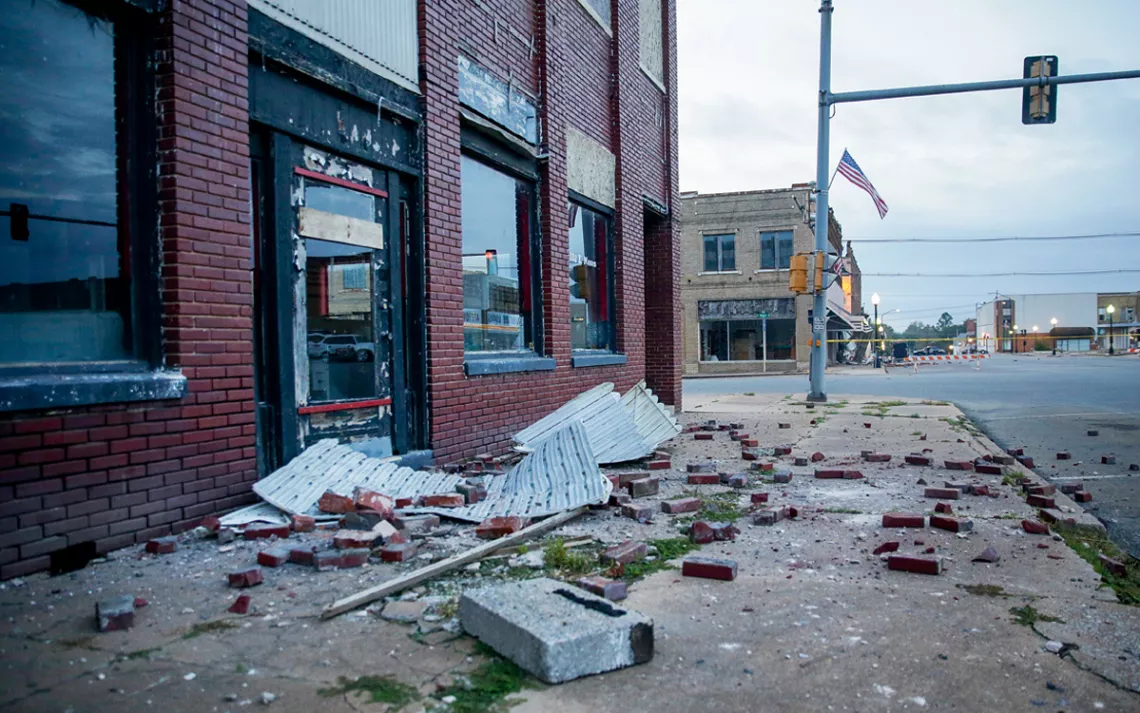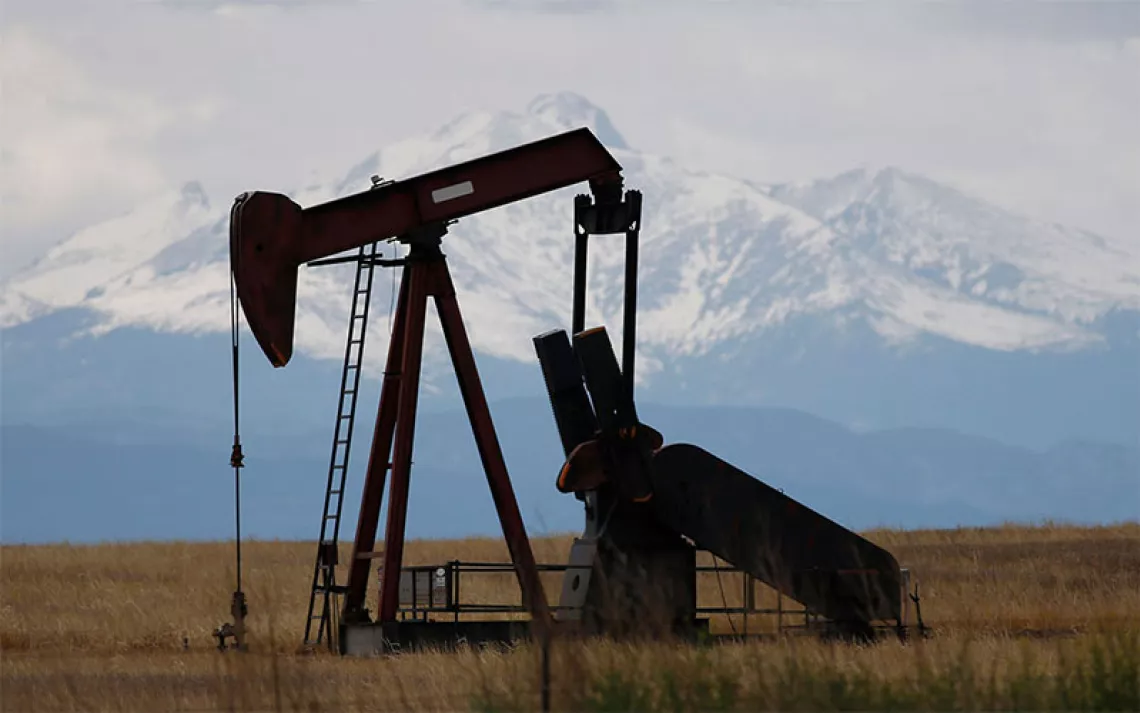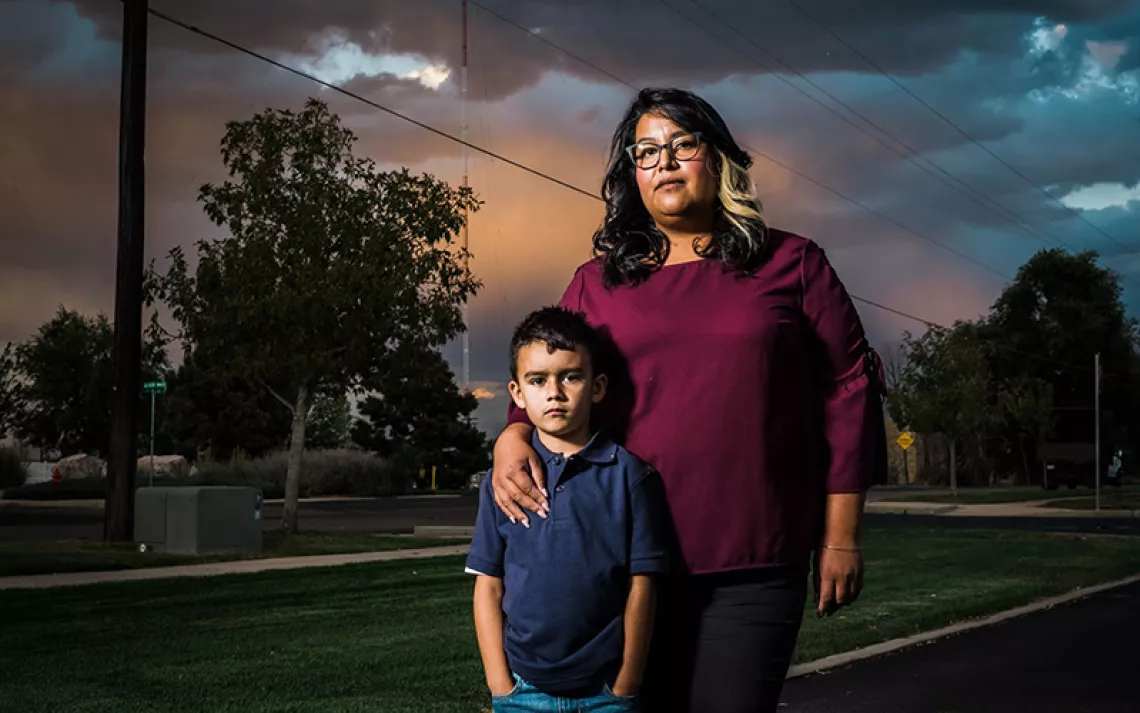Oil Drilling Is—Literally!—Shaking Up Oklahoma
Oil drillers duck and cover to avoid responsibility for the earthquakes they're causing

Earthquake damage in downtown Cushing, Oklahoma, in November 2016 | Photo by Mike Simons/Tulsa World/AP
LAST NOVEMBER, DON AMON was about to sit down to a dinner of his wife's famous chicken and noodles when he heard a loud bang.
"It was like an explosion," says Amon, the chair of the board of commissioners for the town of Cushing, Oklahoma. "It was like we got lifted. And then the shaking started, the violent shaking." Cushing, population roughly 7,800, had just been hit by a magnitude-5.0 earthquake—one of the largest ever recorded in the state.
Oklahoma wasn't always earthquake country. Before 2008, the state had only one or two quakes with a magnitude of 3.0 or above each year. Then the boom in advanced oil and gas recovery hit. The new technology delivered nine barrels of water for every barrel of oil, and the cheapest way to dispose of those millions of gallons was to inject them deep into the earth. The pressure and lubrication of the water unclamped long-dormant faults, and the result was earthquakes. Lots of them.
In 2016, Oklahoma recorded 623 quakes of magnitude 3.0 or greater—more than the combined number in shake-prone California and Nevada. "We had a little ticker the other day," Amon says. "Another one yesterday that was a little bump. Then we had one today that was like a roller. My thought was, 'Uh-oh, somebody must be jamming water into the ground again.'"
Amon's explanation is not controversial. Since 2015, even Oklahoma's notoriously pro-petroleum state officials have acknowledged the connection between the earthquakes and the wastewater-injection wells. Last year the Oklahoma Corporation Commission, which regulates oil and gas drilling, got the state's major oil producers to voluntarily reduce injected wastewater by as much as 40 percent. The almost-immediate result was a one-third reduction in magnitude-3.0-plus earthquakes.
That's cold comfort for those sweeping up rubble. The November Cushing quake may have been mild by California standards (the state's devastating 1989 Loma Prieta earthquake was 63 times more powerful), but Oklahoma buildings weren't built with seismic safety in mind. The quake did a fair amount of damage to the historic downtown, destroying the American Legion center and the building where the Lions Club met. The town's poorest neighborhoods—where people had the fewest resources for rebuilding—suffered the most. No help has been forthcoming from the state or federal governments, and Oklahoma's oil companies have yet to step forward.
"It's not like we want a million dollars from these people," Amon says. "We just want to make sure our buildings are structurally sound."
Adding to the anxiety is the fact that while the number of earthquakes has declined, their intensity has increased. The biggest so far was a 5.8 temblor last September that hit the town of Pawnee, 25 miles north of Cushing. Mark Petersen, chief of the national seismic hazard mapping project at the U.S. Geological Survey, notes that the possibility remains for even larger quakes—magnitude 6.0 or even 7.0—if several ruptures line up.
That's particularly alarming in Cushing, which calls itself the Pipeline Crossroads of the World. The area is home to one of the globe's largest oil-storage facilities, a vast plain of tanks with a combined storage capacity of more than 80 million barrels of crude oil. Shortly after the 5.0 quake in Cushing, EPA regional administrator Ron Curry sent a letter to officials at the Oklahoma Corporation Commission about the "disturbing upward trend in event magnitudes."
The letter cited a Department of Homeland Security report that says that a magnitude-5.7 quake could damage tanks at the Cushing oil hub and that "a breach in the integrity of the Cushing pipelines and storage facilities could be catastrophic for both the environment and the national energy system."
"We don't know what 21,000 small earthquakes does to a pipeline," says Johnson Bridgwater, director of the Sierra Club's Oklahoma Chapter. In 2016, the Club sued four energy companies, demanding that they substantially reduce wastewater injection and shore up structures vulnerable to quakes. (The suit was dismissed in April after the state took steps to reduce the volume of injections.)
The suit, which argued that the injection process poses an imminent and substantial endangerment to the public, was an unusual application of the Resource Conservation and Recovery Act, usually applied to solid waste. But legal creativity was required to deal with an unprecedented situation. In March, the 3,200-member Pawnee Nation filed suit in tribal court against two other oil companies, seeking compensation for severe earthquake damage to the tribe's administrative complex. Other class action suits have been filed in state court.
All of these lawsuits have a similar goal—to get oil producers to take responsibility for the havoc they've caused. (Insurance companies have largely refused to cover building damage, denying 270 of 274 claims in Pawnee alone after the 5.8 quake.) If Oklahomans were hoping for support from their state, they have been disappointed. After a 5.7-magnitude earthquake hit the town of Prague in 2011, Oklahoma attorney general Scott Pruitt (now President Donald Trump's EPA administrator) sat on his hands, even as the state continued to be rocked by quakes. "He has been completely silent," Bridgwater says.
Geologists say that if oil companies continue to reduce their use of disposal wells, the earthquakes in Oklahoma are likely to taper off, although stronger, more infrequent quakes may continue for some time. But even if Oklahoma solves its earthquake problem, says Todd Halihan, a professor of geology at Oklahoma State University, we should see the episode as a cautionary tale. "The things we do with the earth have the potential to induce seismicity," he says. "As we ramp that up, there are going to be more earthquakes in more places."
This article appeared in the July/August 2017 edition with the headline, "Shake, Rattle, and Sue."
 The Magazine of The Sierra Club
The Magazine of The Sierra Club






